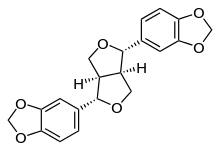Sesamin
Sesamin is a lignan isolated from the bark of Fagara plants and from sesame oil. It has been used as a dietary fat-reduction supplement, although no controlled studies on this application have been performed.[1] Its major metabolite is enterolactone, which has an elimination half life of less than 6 hours.[2] Sesamin and sesamolin are minor components of sesame oil,[3] on average comprising only 0.14% of the oil by mass.[4]
 | |
| Names | |
|---|---|
| IUPAC name
5,5'-(1S,3aR,4S,6aR)-tetrahydro-1H,3H- furo[3,4-c]furan-1,4-diylbis(1,3-benzodioxole) | |
| Other names
Fagarol Sezamin Pseudocubebin Episesamin Asarinin Eleutheroside B4 D-(+)-Sesamin d-Sesamin (+)-Sesamin l-Sesamin | |
| Identifiers | |
3D model (JSmol) |
|
| ChEBI | |
| ChEMBL | |
| ChemSpider | |
| ECHA InfoCard | 100.124.366 |
| KEGG | |
PubChem CID |
|
| UNII | |
CompTox Dashboard (EPA) |
|
| |
| |
| Properties | |
| C20H18O6 | |
| Molar mass | 354.35 g/mol |
Except where otherwise noted, data are given for materials in their standard state (at 25 °C [77 °F], 100 kPa). | |
| Infobox references | |
See also
- Sesamol, another phenolic component of sesame oil
References
- Kamal-Eldin A; Moazzami A; Washi S (January 2011). "Sesame seed lignans: potent physiological modulators and possible ingredients in functional foods & nutraceuticals". Recent Pat Food Nutr Agric. 3 (1): 17–29. doi:10.2174/2212798411103010017. PMID 21114470.
- Peñalvo JL; Heinonen SM; Aura AM; Adlercreutz H (May 2005). "Dietary sesamin is converted to enterolactone in humans". J. Nutr. 135 (5): 1056–1062. doi:10.1093/jn/135.5.1056. PMID 15867281.
- Lim JS, Adachi Y, Takahashi Y, Ide T (Jan 2007). "Comparative analysis of sesame lignans (sesamin and sesamolin) in affecting hepatic fatty acid metabolism in rats". Br J Nutr. 97 (1): 85–95. doi:10.1017/S0007114507252699. PMID 17217563.
- Ikan, Raphael (1991). Natural Products: A Laboratory Guide 2nd Ed. San Diego: Academic Press, Inc. p. 50. ISBN 978-0123705518.
External links
- Effect of sesamin on serum cholesterol and triglycerides levels in LDL receptor-deficient mice
- A short and stereoselective total synthesis of (±)-sesamin by radical cyclisation of an epoxide using a transition-metal radical source
- Sesamin and episesamin induce apoptosis in human lymphoid leukemia Molt 4B cells.
This article is issued from Wikipedia. The text is licensed under Creative Commons - Attribution - Sharealike. Additional terms may apply for the media files.